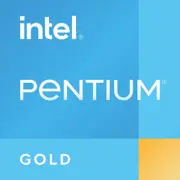Intel Pentium Gold 7505

Intel Pentium Gold 7505: Budget Processor for Everyday Tasks
April 2025
Architecture and Manufacturing Process: 10 nm SuperFin and Mobility Optimization
The Intel Pentium Gold 7505 processor, introduced as part of the Tiger Lake lineup, is designed for budget laptops where energy efficiency and compactness are key factors.
Cores, Threads, and Clock Speeds
- 2 cores / 4 threads: Base frequency — 2.0 GHz, maximum in Turbo Boost mode — up to 3.5 GHz.
- 10 nm SuperFin: The manufacturing process provides lower heat generation and better power consumption compared to 14-nm chips from previous generations (e.g., Pentium Gold 6405U).
Integrated Graphics
- Intel UHD Graphics for 11th Generation: 48 execution units (EUs), supports 4K@60 Hz via HDMI 2.0 or DisplayPort.
- Technologies: Supports AV1 decoding, useful for video streaming, and DirectX 12 for basic gaming.
Power Consumption and TDP: Balance Between Power and Autonomy
- TDP 15 W: Typical figure for ultrabooks. At minimal load, consumption drops to 5–7 W.
- Thermal Design: Allows for passive cooling in some thin devices (e.g., Chuwi Minibook X).
Performance: What Can the Pentium Gold 7505 Do?
Geekbench 6 test results (1353 / 2590) position it at the level of the Intel Core i3 10th generation, but with improved energy efficiency.
Real Tasks
- Office Work: Easily handles a web browser (10+ tabs), Microsoft Office, and Zoom.
- Multimedia: Streams 4K video on YouTube, edits simple videos in Shotcut (with lag during complex effects).
- Gaming:
- CS:GO — 40–50 FPS on low settings (720p).
- Minecraft — 50–60 FPS (1080p, minimal graphics).
- Modern AAA titles (e.g., Cyberpunk 2077) — not recommended.
Turbo Boost Mode
- Brief loads (e.g., opening heavy PDF files): Frequency peaks at 3.5 GHz.
- Sustained loads (video rendering): Frequency stabilizes at 2.8–3.0 GHz due to cooling limitations.
Usage Scenarios: Who Is This Processor For?
1. Students: For studying (typing, presentations, online courses).
2. Office Employees: Working with email, spreadsheets, corporate applications.
3. Home Users: Watching Netflix, social media, video calls.
4. Travelers: Compact laptops with long battery life (e.g., Lenovo IdeaPad Slim 3).
Not suitable for: Gamers, designers, engineers working with CAD.
Battery Life: How Long Will the Laptop Last?
- Usage Time:
- Web surfing — 8–10 hours (with a battery capacity of 50 Wh).
- Video — up to 12 hours (thanks to hardware AV1 decoding).
- Energy-Saving Technologies:
- Intel Speed Shift: Dynamic frequency management.
- C-States: Puts unused cores into sleep mode.
Comparison with Competitors
AMD Ryzen 3 5425U (Zen 3, 4 Cores / 8 Threads)
- Pros: Better multi-threaded performance (Geekbench 6 Multi Core ~3200).
- Cons: Higher laptop prices (from $450 compared to $350 for Pentium).
Apple M1 (in base MacBook Air)
- Pros: 2–3 times higher performance, 18 hours of battery life.
- Cons: Starting price of $999, limited compatibility with Windows software.
Intel Core i3-1115G4 (2 Cores / 4 Threads)
- Pros: Frequencies up to 4.1 GHz, 15–20% faster in single-threaded tasks.
- Cons: Laptops cost $50–100 more.
Pros and Cons of Pentium Gold 7505
Strengths:
- Low cost of laptops (from $300).
- Support for modern standards: Wi-Fi 6, Thunderbolt 4 (in some models).
- Sufficient performance for everyday tasks.
Weaknesses:
- Only 2 cores: Multitasking is limited (e.g., lag when running Photoshop and a browser simultaneously).
- No support for PCIe 4.0: SSDs operate on PCIe 3.0 x4 (up to 3.5 GB/s).
Laptop Selection Recommendations
1. Device Type: Ultrabooks (Acer Swift 1) or compact laptops (HP 14s-dq).
2. RAM: Minimum 8 GB (preferably 16 GB for future-proofing).
3. Storage: SSD is a must (256 GB and above).
4. Screen: Full HD (1920×1080) — reduces eye strain.
5. Additional: Check for the presence of USB-C with charging support.
Examples of Models for 2025:
- ASUS Vivobook Go 14 ($329): 8 GB RAM, 256 GB SSD, 14" FHD.
- Dell Inspiron 15 3520 ($349): 8 GB RAM, 512 GB SSD, HDD slot.
Final Conclusion: Who Should Buy the Pentium Gold 7505?
This processor is a great choice for those looking for an affordable laptop for basic tasks. Its key advantages include:
- Price: Devices are cheaper than equivalents with Ryzen 3 or Core i3.
- Energy Efficiency: Up to 10 hours of usage without recharging.
- Modern Technologies: Support for Wi-Fi 6, Thunderbolt 4.
Who should buy:
- Students for studying.
- Seniors for communication and hobbies.
- Offices as corporate devices.
Who should look for alternatives:
- Gamers — consider Ryzen 5 or Intel Core i5 with discrete graphics.
- Freelancers — better to go for Core i5 / Ryzen 5 and 16 GB RAM.
Price Range for Laptops: $300–$400 (new models, 2025). If your budget is over $500, it makes sense to choose a more powerful CPU.
Basic
CPU Specifications
Memory Specifications
GPU Specifications
Miscellaneous
Benchmarks
Compared to Other CPU
Share in social media
Or Link To Us
<a href="https://cputronic.com/en/cpu/intel-pentium-gold-7505" target="_blank">Intel Pentium Gold 7505</a>